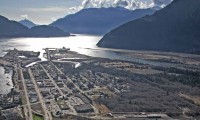Development Cost Charges
Development Cost Charge bylaw update underway
An update to the Development Cost Charge Bylaw and introduction to Amenity Cost Contributions is underway. Adoption of new DCC rates is expected in March 2025.
Development Cost Charge bylaw updated September 2022
District of Squamish Council adopted an updated Development Cost Charge (DCC) bylaw in September 2022 to allow the District to collect revenue that keeps pace with the increasing costs of infrastructure required to service community growth. The new DCC rates are in line with rates charged in similar communities, and the anticipated revenue amounts will be factored into future capital planning within the Five-Year Financial Plan.
DCC bylaws are typically updated every few years to keep up with changing growth patterns and increasing costs of infrastructure. The DCC bylaw was previously updated in 2020. View background information further down this page.
Growth helping to pay for growth
Development contributions through DCCs benefit the community by delivering infrastructure to ensure that existing taxpayers are not burdened with costs associated with the demands of new development. DCCs are governed by provincial legislation and can fund a very specific list of projects: sewer, water, drainage, parks and roads.
DCC rate changes work to ensure Squamish is receiving an appropriate contribution towards the cost of the growth projects in the community, while ensuring that Squamish remains competitive (for development opportunities) with other communities.
A DCC Bylaw helps to:
- Communicate the costs of infrastructure upgrades to the development community.
- Ensure the costs of growth are distributed fairly.
- Apply the principle of ‘growth pays for growth'.
- Allow municipalities to save for growth-related infrastructure.
Projects funded by DCCs in our community include the Pioneer Way extension project, Wastewater Treatment Plant upgrades and the future Pemberton Bridge (which is currently being saved for).
New rates
The updated DCC Bylaw was developed based on the District’s infrastructure needs and costs identified through recently completed master plans and studies relating to sewer, water, drainage, parks and roads. Facilities are not eligible for DCC funding.
DCC Rate Comparison, 2020 vs 2022
| Land Use | Unit | 2020 DCC Bylaw Totals |
2022 DCC Bylaw Totals |
Percent (%) Change |
| Residential Single Family Low Density | per lot | $18,854 | $21,616 | +15% |
| Residential Single Family Small Lot | per lot | $15,922 | $16,603 | +4% |
| Residential Medium Density (Townhouse) | per unit | $10,618 | $10,747 | +1% |
| Residential High Density (Apartment) | per unit | $7,120 | $7,677 | +8% |
| Commercial | per m2 of GFA | $111.57 | $117.64 | +5% |
| Institutional | per m2 of GFA | $90.10 | $99.89 | +11% |
| Industrial | per m2 of GFA | $79.86 | $78.88 | -1% |
Background
In 2021, the District initiated the process to update the existing Development Cost Charge (DCC) Bylaw No. 2762, 2020 (Bylaw) in accordance with the OCP. The 2020 DCC bylaw was based on a 20-year growth projection (2020-2040) and was updated utilizing current plans and reports that reflected different growth rates and impacts to the District’s DCC priorities. To establish future residential, commercial, industrial and institutional growth projections, data was sourced from:
- Build-out analysis;
- Staff inputs;
- Review subdivision and building permit records (growth units); and
- Local building permit values and construction cost estimates.
Rates for the 2022 DCC bylaw were then determined using financial modeling created by an external consultant that included:
- A review of residential and non-residential growth estimates;
- Identifying eligible DCC projects, cost estimates and appropriate benefit allocations;
- Updated cost estimates of existing program projects;
- Determination of appropriate land use categories and units of charge; and
- Allocation of costs based on impact on infrastructure.
Draft DCC rates were first presented to the Committee of the Whole on December 14, 2021, and staff proceeded with a series of stakeholder consultations in February 2022. These meetings provided opportunity for the development community to ask questions, raise concerns, and provide feedback on the new rates.
DCCs and when they are charged
Development Cost Charges (DCCs) are a provincially regulated cost-recovery tool used by the District to support financial sustainability and to adequately service the demands of new development which included new or expanded infrastructure such as such as sewer, water, drainage, parks and roads.
DCCs are charged on new developments, small and large, that involve:
- Subdivision of property
- Addition of new dwelling units
- Expansion of commercial, industrial and institutional buildings.
The District of Squamish’s Development Cost Charges are established by bylaw with the approval of the Inspector of Municipalities, and guided under the Local Government Act, Development Cost Charges Best Practices Guide, and the District’s Official Community Plan (OCP) and its suit of Master Plans.
View the updated Development Cost Charge Bylaw No. 2911, 2022
Community Amenity Contributions (CACs)
The second way development can support community growth is through CACs.
CACs are cash or in-kind contributions that developers provide to help address community needs that result from population growth, and that don't have funding through other legislated fees, such as DCCs.
The District negotiates CACs as part of new development applications (rezoning applications and OCP Bylaw amendments only).
CACs can fund projects such as recreational facilities and publicly owned affordable housing. Unlike DCCs, CACs do not fund infrastructure improvements for new development.
The District of Squamish adopted an updated CAC policy in October 2023 to guide how the District collects CACs from new developments going forward.
View the most recent CAC policy in the Policy Library.
Explore interactive maps for property information, utilities, parks.. and more.
